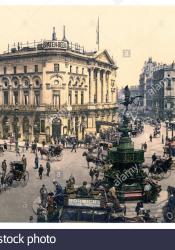Piccadilly Circus (1819) [Historical] (Ch 4; pg. 225)
With the final lines of “The Eighteenth century was over; the Nineteenth century had begun,” chapter four ends in a chilling tone that leaves much of the story up in the air. Chapter four ends with the description of a dark, doubtful, confusing cloud that covers the city. Is this cloud metaphorical or literal? It doesn’t hurt if it is both, but it would be wise to see it in a metaphorical light at the moment. This cloud is spanning over the lights of London at midnight, covering the expanse of the city in a patch of night-time shadow. The location of Piccadilly is mentioned in this section. I find it interesting that it is mentioned here, right before the ominous words that suggest a large shift in the narrative to accompany the shift in centuries.
Piccadilly Circus was created in 1819, at the junction with Regent Street, which was then being built under the planning of John Nash on the site of a house and garden belonging to a Lady Hutton; the intersection was then known as Regent Circus South (just as Oxford Circus was known as Regent Circus North) and it did not begin to be known as Piccadilly Circus until the mid 1880s, with the rebuilding of the Regent Street Quadrant and the construction of Shaftesbury Avenue. In the same period the circus lost its circular form (“Piccadilly Circus”).
I think the fact that the actual Piccadilly Circus wasn’t created until 1819, yet at the turn of the century in the novel, the place of Piccadilly is mentioned is extremely important. It shows that Woolf was thinking about the effects of industrialization, not only on the narrative of the story, but on the historical context of the time.
(291 words)
“Piccadilly Circus.” Encyclopædia Britannica, Encyclopædia Britannica, Inc., www.britannica.com/topic/Piccadilly-Circus.

